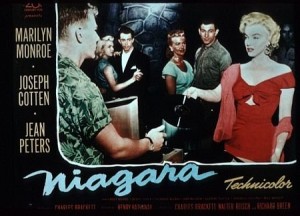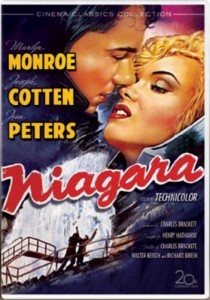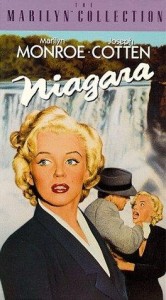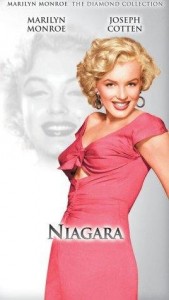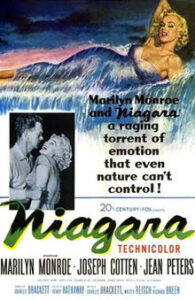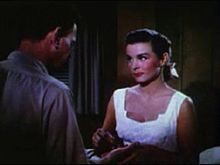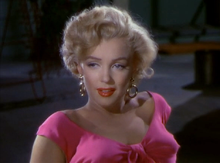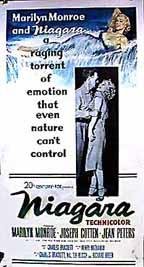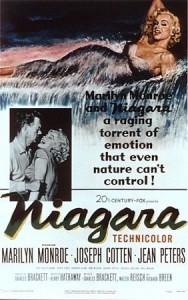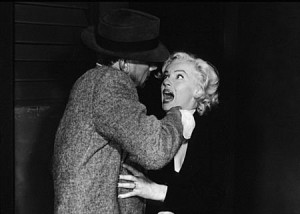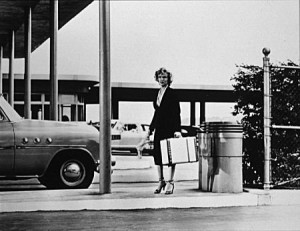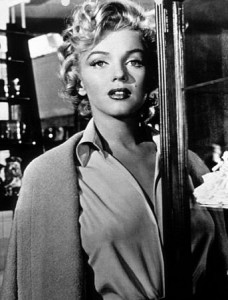Niagara **** (1953, Marilyn Monroe, Joseph Cotten, Jean Peters) – Classic Movie Review 723
Director Henry Hathaway’s 1953 movie Niagara is a brilliantly sexy, steamy and entertaining noirish crime thriller. After years in bit parts, the sexy young Marilyn Monroe rockets at last to stardom as Rose Loomis, the promiscuous wife who plans to bump off her husband George (Joseph Cotten) while honeymooning at a Niagara Falls motel. Monroe has to play a ‘raging torrent of emotion that even nature can’t control’ and she really pulls this outrageous notion off.
Rose plots with slimy Ted Patrick (Richard Allan) to bump George off but, after he is reported missing, fellow honeymooner Polly Cutler spies him at the motel, though her new husband Ray thinks she’s imagining it. Now Rose is in trouble.
Niagara was advertised as a high water mark in suspense, and this time they didn’t exaggerate. Much of Niagara’s success is thanks to Monroe’s bold and brassy iconic appearance and to Cotten’s portrayal of smouldering appearance of outer calm that’s actually a fire bomb about to explode, an expertly controlled and delivered performance that contrasts perfectly with Monroe’s much flashier turn.
If Monroe and Cotten are the in-their-prime stars and obvious main attractions here, they sometimes have competition from their glorious co-star, Niagara Falls itself, which in cinematographer Joseph MacDonald’s lenses looks even more amazing than the real thing if you go visit there. It’s all filmed in the loveliest Technicolor which has rarely seemed more unreal or exciting. It’s one gorgeous looking movie.
Jean Peters and Casey Adams (aka Max Showalter) play Polly and Ray Cutler, another honeymooning couple in Niagara, who get embroiled in the plot. Unfortunately, they’re pretty dull but then they have dull roles to play.
The Cutlers are on a delayed honeymoon and politely if reluctantly accept a less desirable cabin when they find their reserved cabin occupied by the Loomises, so the two couples become acquainted. Next day, Polly sees Rose kissing her lover Ted Patrick and later the Cutlers witness George’s rage.
It’s a slight pity that the screenplay by Charles Brackett, Walter Reisch and Richard L Breen (based on a story by Walter Reisch) lacks real ambition or big surprises or shock plot revelations, not going the last nine yards.
And it’s a little bit of a shame too that there’s no special flair or quirky distinction in Hathaway’s merely professional direction, not seeking to push any envelopes. Just think what Hitchcock could have done with it. That said, Niagara has plenty of charms, atmosphere and suspense, and is a stupendous thriller, just the same.
‘Kiss’ (music by Lionel Newman, lyrics by Haven Gillespie) is played on the phonograph and sung in part by Marilyn.
The cast are Marilyn Monroe as Rose Loomis, Joseph Cotten as George Loomis, Jean Peters as Polly Cutler, Max Showalter [Casey Adams] as Ray Cutler, Richard Allan as Patrick, Denis O’Dea as Inspector Starkey, Don Wilson as Mr Kettering, Lurene Tuttle as Mrs Kettering, Russell Collins as Mr Qua, Will Wright as Boatman, Henry Beckman, Harry Carey Jr, Bill Coontz, Robert Ellis, Neil Fitzgerald, Gloria Gordon, Winifield Hoeny, George Ives, Arch Johnson, Lester Matthews, Norman McKay, Audre Monture, Patrick O’Moore, Marjorie Rambeau, Tom Reynolds, Willard Sage, Minerva Urecal, Nina Varela, Gene Wesson, and Carleton Young.
Writer Walter Reisch recalled that he suggested a murder mystery when producer Charles Brackett proposed a film set around Niagara Falls. Reisch said: ‘Anybody hearing the name Niagara thinks of honeymoon couples and of some sentimental story of a girl walking out on her husband on their wedding night and their getting together again. I wanted to make it a mystery story, with a real murder in it.’ Reisch said he came up with the story and wrote the script with Brackett and Richard Breen.
Reisch recalled that 20th Century Fox studio boss Daryl F Zanuck said he wanted to put Monroe in the film. ‘There came a second telephone call that he wanted her to be the villainess, not the girl. My God! Here was the prettiest girl in the whole United States of America! But he insisted it was a great idea, so we finally did it. We didn’t know whether she would like it, but she had no objection, whatsoever, on the contrary.’
Originally Jean Peters was playing the main character, but the film became a vehicle for Monroe, whose career was igniting while that of Peters was beginning to fizzle. Unlike Monroe, Peters resisted being turned into a sex symbol. She said: ‘A clothes horse seldom has lines or situations that pierce the outer layer and get into the core of life.’ Unfortunately, this made her less valuable to Hollywood, and has made her much less well remembered.
Reisch said there are major sequences missing from the film. ‘After he’d seen it, Zanuck simply couldn’t accept the fact that the police at Niagara Falls were Canadian. We had British actors playing Canadian police commissioners, detectives and cops, and he just abhorred it. He wouldn’t let us go back to the stages to finish it or to repair it. He just took it out! The American audience, he said, does not know, does not understand, that the Niagara Falls are bisected by the border, and we should have used Americans. And Hathaway, who didn’t like the idea either, sided with him. So there are big holes in the story.’
Hence, no doubt, its short running time of 88 minutes. But it feels taut and compact, and no one notices any holes in the story.
Supposedly, the film holds the record for the longest filmed walk in the history of cinema.
Niagara is noirish. It is not really a true film noir. Joseph MacDonald shoots in three-strip Technicolor rather than the shadowy black and white expected of a film noir. Though this is a blaze of Technicolor, the fire was going out. It was virtually the end of three-strip Technicolor at Fox, which soon began converting to CinemaScope, which was compatible with Eastmancolor.
Shooting took place in the summer of 1952 and it was released on 21 January 1953 in the US. It was a hit, costing $1.67 million and earning $2.35 million.
Peters had a seven-year contract with Fox. 1953 was her year in the movies, following Niagara with Pickup on South Street, where the director Samuel Fuller chose her over Monroe. Peters’s third film in 1953, A Blueprint for Murder, reunited her with Joseph Cotten and in 1953 she also starred in the film noir Vicki. She married Howard Hughes and retired from films in 1957.
© Derek Winnert 2014 Classic Film Review 723 derekwinnert.com

